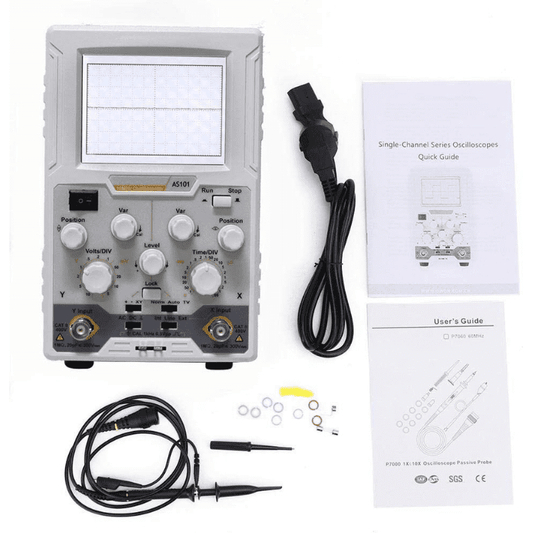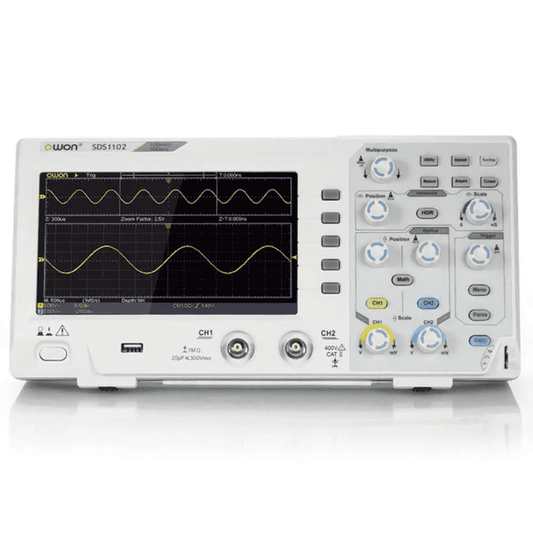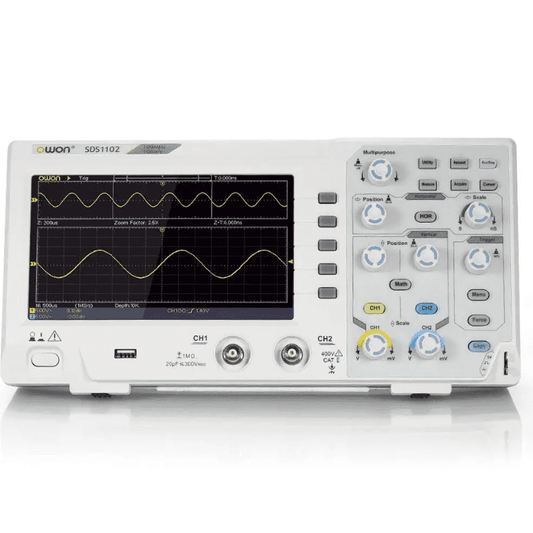Quality is good
This little thing is amazing! It's easy to use, works well, and it's so tiny. Definitely lovable!
Free Delivery on Orders Above Rs 500/- Pan-India
Cash on Delivery Available for Orders above Rs.500/- and Upto Rs 3000/-
GST Invoices for Your Business
Dedicated Technical Support Team
Safely Delivering Genuine Products PAN INDIA



Robocraze
Couldn't load pickup availability
The DSO138 DIY oscillator kit is integrated with an ARM Cortex-M3 processor (STM32F103C8), and includes a 2.4-inch color TFT display screen, that can be used as the ARM test development board. This is DSO138 2.4″ TFT Handheld Pocket-size Digital Oscilloscope Kit. It features automatic, regular, and one-shot modes, easy to capture the moment waveform.
It's easy and reliable for circuit operation. This DSO138 oscilloscope kit can display frequency, period, pulse width, duty ratio, MAX./MIN./AVG./Peak-Peak/virtual values.
This boost converter is a great match for the DSO138 oscilloscope kit. It can be connected directly to the DSO138 motherboard(not included), making the DSO138 oscilloscope to be a portable oscilloscope for better use.
Also check the Acrylic Case Shell for DIY DSO138 Oscillator Kit available on the Robocraze website. It is a specially designed DIY acrylic case for the DSO138 oscilloscope, offering protection while maintaining the aesthetic appeal of the digital oscilloscope.
| LCD Screen | 2.4 inch |
| Processor | ARM Cortex-M3 processor |
| Analog Bandwidth | 0-200KHz |
| Sampling Buffer Depth | 1024 bytes |
| Accuracy | 12 Bit |
| Model | DSO138 |
| Vertical sensitivity | 10mV/Div – 5V/Div |
| Input impedance | 1M ohm |
| Dimensions | 128*88*27mm |
| Weight | 50 grams |
For more details, please check our Shipping and Return Policy






There is always some capacitance between the oscilloscope input and the grounded probe, which must be calibrated to better measure high frequency signals. This can be done using built-in test signals. To do this, follow the steps below.
Follow the below mentioned steps to use a DSO oscilloscope.
The maximum voltage for the DSO138 oscilloscope is 5 volts per division (5V/Div).
The DSO138 Oscilloscope Kit is a handheld pocket-size digital oscilloscope designed for electronic enthusiasts and hobbyists. It comes in the form of a DIY kit, which means you'll need to assemble it yourself. Once assembled, it provides a compact and portable solution for viewing and analyzing electronic signals in various circuits.
The DSO138 Oscilloscope Kit is integrated with an ARM Cortex-M3 processor, specifically the STM32F103C8 model. This processor serves as the core processing unit of the oscilloscope, enabling it to efficiently handle signal processing tasks and control the display interface. It ensures reliable performance and provides the necessary computing power for accurate waveform analysis.
Yes, the DSO138 Oscilloscope Kit is suitable for beginners with some basic electronics knowledge. While assembly requires soldering and careful following of instructions, it's a great learning experience for those interested in understanding oscilloscope functionality and electronics principles.
Calibrating the DSO138 Oscilloscope Kit involves adjusting certain settings to ensure accurate measurements. One method involves using built-in test signals and adjusting switches and trimmers accordingly. Following a calibration procedure ensures the oscilloscope provides reliable and accurate results during waveform analysis.
Yes, the DSO138 Oscilloscope Kit is suitable for educational purposes, particularly in teaching basic principles of electronics, waveform analysis, and signal processing. Its compact size, affordability, and ease of use make it an ideal tool for classroom demonstrations and student projects.

This little thing is amazing! It's easy to use, works well, and it's so tiny. Definitely lovable!

I received it already assembled, just as described. It's very helpful for learning and getting used to using an oscilloscope.

This is a great purchase for its price. It's easy to use, portable, and provides detailed screen information that's easy to read.

I wish I had this back in 2019 when I was making a PWM controller. It's a great purchase for the price. It's easy to use and portable, and the screen shows detailed information that's easy to read.



not very accurate, not very reliable but excellent för the money

Very functional, it has all the basic functions. reacts very quickly, is easy to use

Worked great straight away. Easy to use interface to alter the x and y range and there are my waves.

Useful low frequency oscilloscope

Was fun to build and it works. I wouldn't recommend it as a first electronics project.
© 2023, TIF Labs Pvt. Ltd.
